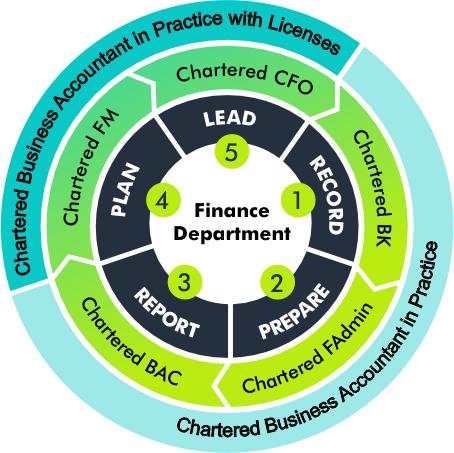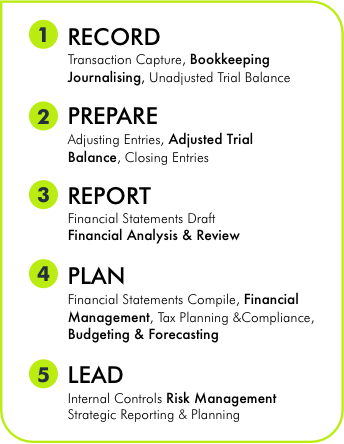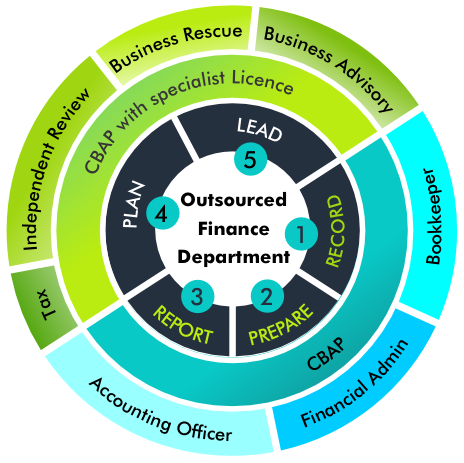
Chartered Chief Financial Officer (CCFO)
You’re steering the whole organisation’s financial future
Why Become a Chartered Chief Financial Officer?
You’ve moved beyond management. You lead strategy, guide the executive team, and protect the organisation from risk.
Now it’s time for a designation that reflects your level
Confirms your credibility as a board-level finance executive
Recognises your mastery of 34 critical CFO competencies
Developed in collaboration with ICFOA, the global body for finance executives
Built on an international CFO competency framework
Opens doors to an elite network of modern finance leaders
If you’re already doing the job, this is the title that proves it.
Become a CCFO
Join now and receive
the essential credential
for career development
R1181pm
for 6 months
Steps to becoming a Chartered Chief Financial Officer (CCFO)
-
Every finance department has different levels:
Functional: Data capturing, invoice processing
Administrative: Reconciliations, VAT returns, month-end support
Operational: General accounting and reporting
Management: Oversees teams, budgets, forecasting and compliance
Strategic: Sets direction, leads finance strategy, advises the board
CCFO is the designation for the strategic level of the Finance Department.
When you hold this title, you’ve gone beyond running finance, you’re shaping the organisation’s future.
-
CCFO is for you if:
You’ve moved beyond operational and management roles into strategic leadership.
You sit on the board or report directly to it.
You make decisions that influence the organisation’s growth, risk, and long-term strategy.
Minimum requirements:
MBA or NQF Level 9 degree in Financial Management, Business Administration, or Accounting.
8–10 years’ senior-level experience (including at least 4 years at a strategic level).
Proof you’ve mastered CIBA’s 34 critical CFO competencies.
-
CCFOs operate at the highest level of financial decision-making:
Develop and drive the organisation’s financial strategy.
Advise the board and executive team on risk, growth, and investment.
Oversee mergers, acquisitions, and capital raising.
Lead governance, compliance, and ethical financial conduct.
Guide long-term planning, budgeting, and forecasting.
Represent the organisation to shareholders, investors, and regulators.
-
Becoming a CCFO is about proving you can lead at the highest level:
Become a member
Create your profile and sign-up as a CIBA member at myciba.org
Apply for the CBAP designation
Upload ID, CV, qualifications, and proof of experience
Provide two senior-level references
Complete the Professional Readiness Programme
Pay your designation fee (monthly or annual)
Get evaluated and receive your CCFO certificate
-
40 hours CPD per year
Completing an annual ethics course to lock in CIBA rewards
Maintain membership in good standing
Once-off completion of the Professional Readiness Programme
-
CCFO holders may not:
Act in private practice or sign off as Accounting Officers
Perform Independent Reviews or offer public accounting services
Want to consult independently? Add the CBAP designation to open a part-time or full-time practice.
-
At this stage, credibility is everything.
The CCFO designation signals that you’ve earned your place in the boardroom and have the strategic, ethical, and leadership skills to back it up.Recognition as a professional finance leader at the highest level
Your name listed on the National Database of Accountants
Proof of strategic competence, leadership, and ethical commitment
Access to an exclusive international CFO network through IAFEI
-
Most finance professionals hit the same wall, you’ve got the skills, but you’re stuck fighting for recognition, missing out on opportunities, or being overlooked for bigger roles.
CIBA changes that.
Through partnerships with national industry bodies, like ANNET (NPO sector), SACCI (business chambers), Creative Artists, Agriculture, and the legal profession, we:Put your name in front of employers who value CIBA designations.
Train their finance staff, so they know and respect the CIBA standard.
Create sector-wide demand for members with your qualification.
Instead of chasing opportunities, you’ll have them coming to you.
-
CIBA rewards aren’t perks you buy, they’re recognition you earn.
Only members who stay in good standing, follow our ethics, and deliver quality work get access to them.
When you uphold the standard, you unlock:No more paying for learning: your ethics, compliance, and technical CPD is free every year.
Pay less for specialist skills: big discounts on advanced courses, licenses, and short programmes.
Help when you’re stuck: direct access to our technical desk, templates, and guides.
People knowing your worth: your name listed in the National Database of Accountants and featured in member spotlights.
The right connections: from annual conferences to sector-specific networking events.
A say in the rules: we fight your corner with SARS, CIPC, UIF, CIDB, DSD and others so you’re not ignored.
For practice members (CBAP): PI cover, software discounts, and direct client leads so you can grow faster.
We even run our own accounts this way. membership fees are recognised upfront, because the rewards aren’t “paid for” month by month. They’re earned by members who live up to the CIBA standard.
“CCFO gave me the recognition to move from managing the finance team to influencing the company’s entire strategy.”
— Lindiwe M., CCF




